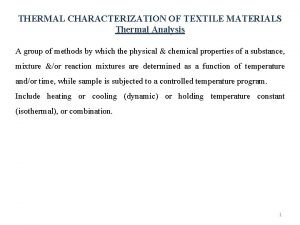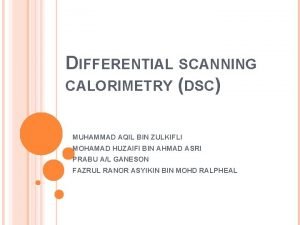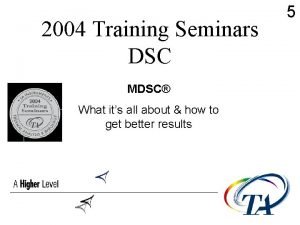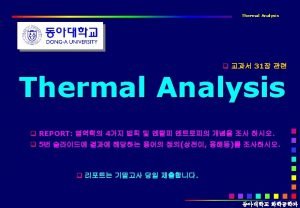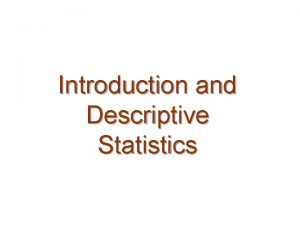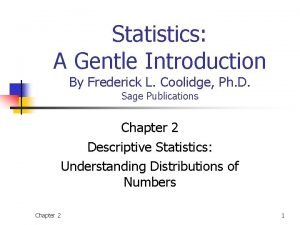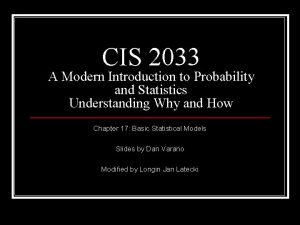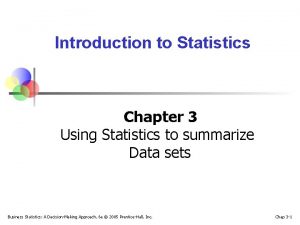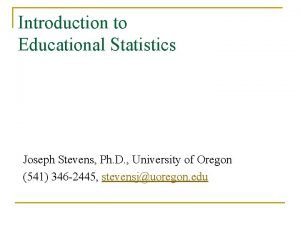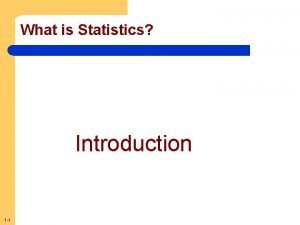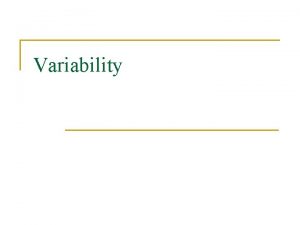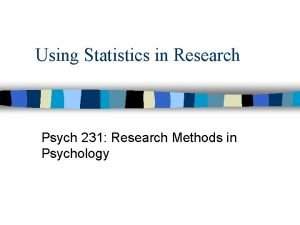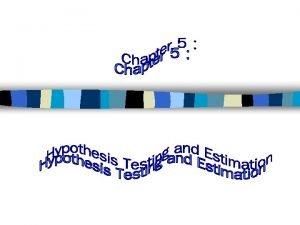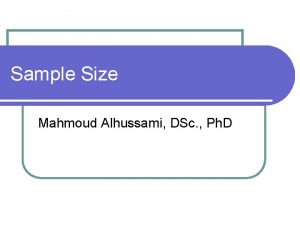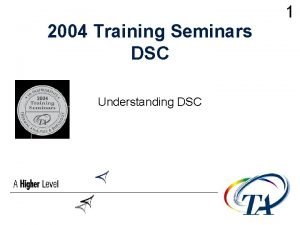Introduction to Statistics Mahmoud Alhussami DSc Ph D



































































- Slides: 67

Introduction to Statistics Mahmoud Alhussami, DSc. , Ph. D.

Course Objectives o o Understand the basic statistical concepts and their application to health care research Differentiate between parametric and nonparametric tests and comprehend their underlying assumptions Decide what statistical technique will provide the best answer to a given research question To expose students to a variety of statistical techniques for dealing with the challenges presented by a given data.

Purposes of Statistics o o o To describe and summarize information thereby reducing it to smaller, more meaningful sets of data. To make predictions or to generalize about occurrences based on observations. To identify associations, relationships or differences between the sets of observations.

Population and Sampling o Population. Universe. The entire category under consideration. This is the data which we have not completely examined but to which our conclusions refer. The population size is usually indicated by a capital N. The entire aggregation of cases that meet a designated set of criteria. n o Examples: every lawyer in Jordan; all single women in Jordan. Sample. That portion of the population that is available, or to be made available, for analysis. A subset of the units that compose the population. A good sample is representative of the population. The sample size is shown as lower case n. n If a company manufactures one million laptops, they might take a sample of say, 500, of them to test quality. The population size is N = 1, 000 and the sample size is n= 500.

Population and Sampling o o o Sampling: the process of selecting portion of the population. Representativeness: the key characteristic of the sample is close to the population. Sampling bias: excluding any subject without any scientific rational. Or not based on the major inclusion and exclusion criteria.

Example o o o Studying the self esteem and academic achievement among college students. Population: all student who are enrolled in any college level. Sample: students’ college at the University of Jordan.

What is sampling? o Sampling is the selection of a number of study units/subjects from a defined population.

Questions to Consider o o Reference population – to whom are the results going to be applied? What is the group of people from which we want to draw a sample (study population)? How many people do we need in our sample? How will these people be selected?

Sampling - Populations Reference Population Study Population Sampling Frame Study Subjects

Population n Is a complete set of persons or objects that possess some common characteristic that is of interest to the researcher. o Two groups: The target population The accessible population

Target Population n The entire group of people or objects to which the researcher wishes to generalize the findings of a study. Target population should meet the criteria of interest to the researcher Example: all people who were admitted to the renal unit for dialysis in Al-Basheer hospital during the period of 2011 – 2013.

Accessible Population n The group of people or objects that is available to the researcher for a particular study

Sampling o o Element: The single member of the population (population element or population member are used interchangeably) Sampling frame is the listing of all elements of a population, i. e. , a list of all medical students in the university of Jordan, 20102014.

Sampling Methods o o Sampling depends on the sampling frame. Sampling frame: is a listing of all the units that compose the study population.

Primary vs Secondary Data o o Primary data. It is the data that has been compiled by the researcher using such techniques as surveys, experiments, depth interviews, observation, focus groups. Types of surveys. A lot of data is obtained using surveys. Each survey type has advantages and disadvantages. n n Mail: lowest rate of response; usually the lowest cost Personally administered: can “probe”; most costly; interviewer effects (the interviewer might influence the response) Telephone: fastest Web: fast and inexpensive

Primary vs Secondary Data o Secondary data. The data that has been compiled or published elsewhere, e. g. , census data. n The trick is to find data that is useful. The data was probably collected for some purpose other than helping to solve the researcher’s problem at hand. n Advantages: It can be gathered quickly and inexpensively. It enables researchers to build on past research. Problems: Data may be outdated. Variation in definition of terms. Different units of measurement. May not be accurate (e. g. , census undercount). n

Survey Errors o Response Errors. Data errors that arise from issues with survey responses. n subject lies – question may be too personal or subject tries to give the socially acceptable response (example: “Have you ever used an illegal drug? “Have you even driven a car while intoxicated? ”) n subject makes a mistake – subject may not remember the answer (e. g. , “How much money do you have invested in the stock market? ” n interviewer makes a mistake – in recording or understanding subject’s response n interviewer cheating – interviewer wants to speed things up so s/he makes up some answers and pretends the respondent said them. n interviewer effects – vocal intonation, age, sex, race, clothing of interviewer may influence response. An elderly woman dressed very conservatively asking young people about usage of illegal drugs may get different responses than young interviewer wearing jeans with tattoos on her body and a nose ring.

Survey Errors o Nonresponse error. If the rate of response is low, the sample may not be representative. The people who respond may be different from the rest of the population. Usually, respondents are more educated and more interested in the topic of the survey. Thus, it is important to achieve a reasonably high rate of response. (How to do this? Use follow - ups. ) n Which Sample is better? Sample 1 n Sample 2 Sample size n = 2, 000 Rate of Response 90% n = 1, 000 20% Answer: A small but representative sample can be useful in making inferences. But, a large and probably unrepresentative sample is useless. No way to correct for it. Thus, sample 1 is better than sample 2.

Types of samples o Nonprobability Samples – based on convenience or judgment n n n o Convenience sample - students in a class, mall intercept Judgment sample - based on the researcher’s judgment as to what constitutes “representativeness” e. g. , he/she might say these 20 stores are representative of the whole chain. Quota sample - interviewers are given quotas based on demographics for instance, they may each be told to interview 100 subjects – 50 males and 50 females. Of the 50, say, 10 nonwhite and 40 white. The problem with a nonprobability sample is that we do not know how representative our sample is of the population.

Probability Samples o Probability Sample. A sample collected in such a way that every element in the population has a known chance of being selected. o One type of probability sample is a Simple Random Sample. This is a sample collected in such a way that every element in the population has an equal chance of being selected. o How do we collect a simple random sample? n Use a table of random numbers or a random number generator.

Probability Samples o Other kinds of probability samples (beyond the scope of this course). n systematic random sample. o Individuals are chosen at regular intervals from the sampling frame o Ideally we randomly select a number to tell us the starting point every 5 th household every 10 th women attending the conference Sampling fraction = Sample size o o o Study population Interval size= study population Sample size n stratified random sample. o n The population is sub-divided based on a characteristic and a simple random sample is conducted within each stratum cluster sample o First take a random sample of clusters from the population of cluster. Then, a simple random sample within each cluster.

Types of Data o Qualitative data result in categorical responses. Also called Nominal, or categorical data n o Example: Sex �MALE �FEMALE Quantitative data result in numerical responses, and may be discrete or continuous. n Discrete data arise from a counting process. o n Continuous data arise from a measuring process. o n Example: How many courses have you taken at this College? ____ Example: How much do you weigh? ____ One way to determine whether data is continuous, is to ask yourself whether you can add several decimal places to the answer. o For example, you may weigh 150 pounds but in actuality may weigh 150. 23568924567 pounds. On the other hand, if you have 2 children, you do not have 2. 3217638 children.

Variables o Measurable characteristic of a person, object or phenomenon which can take on different values n n n n o represent information that must be collected in order to meet the objectives of a study Weight Distance Monthly income Number of children Color Outcome of disease Types of food Sex Variables allow clear definition of the core problem and influencing factors by introducing the concept of value

Types of Variables o o o Continuous (e. g. , height) Discrete (e. g. , number of children) Categorical (e. g. , marital status) Dichotomous (e. g. , gender) Attribute variable vs. Active variable n n Attribute Variable: Preexisting characteristics which researcher simply observes and measures. E. g. blood type. Active Variable: Researcher creates or manipulates this. E. g. experimental drug.

(. Types of Variables (cont Independent variable—the presumed cause (of a dependent variable) Dependent variable—the presumed effect (of an independent variable) Example: Smoking (IV) Lung cancer (DV)

Problem Diagram Poor patient Compliance With therapy Inappropriate Management Of complications High rate of Complicated malaria High rate Of severe malaria Insufficient Peripheral facilities Delayed Health Seeking

Transforming factors into variables Poor patient Compliance With therapy Inappropriate Management Of Of complications High rate of Complicated malaria High rate Of severe malaria Insufficient Peripheral facilities Delayed Health Seeking behaviour

Scale of variable measurement o Continuous variable n o continuum of measurement. Ordinal variables n categorical variables with categories that can be ranked in increasing or decreasing order (high, medium or low income) Ø Ø Ø o Disability Seriousness of diseases Agreement with statement Nominal variables n categorical variables with categories that cannot be ranked in order Ø Ø Sex Main food crops

Mother’s income Confounding Variables Cause (Independent variable) malnutrition Effect/Outcome (Dependent var) Other factor (Confounding variable) Family income

Measurement o o Measurement is the process of assigning numbers to variables to represent the amount of an attribute, using a specified set of rules by counting, ranking, and comparing objects or events. Advantages: n Removes guesswork. n Provides precise information. n Less vague than words.

Levels of Measurement n n Nominal Ordinal Interval Ratio

Levels of Measurement

Nominal Level of Measurement o o o Categories that are distinct from each other such as gender, religion, marital status. They are symbols that have no quantitative value. Lowest level of measurement. Many characteristics can be measured on a nominal scale: race, marital status, and blood type. Dichotomas.

Nominal Level of Measurement o Nominal data is the same as Qualitative. It is a classification and consists of categories. When objects are measured on a nominal scale, all we can say is that one is different from the other. n n o o Examples: sex, occupation, ethnicity, marital status, etc. [Question: What is the average SEX in this room? What is the average RELIGION? ] Appropriate statistics: mode, frequency We cannot use an average. It would be meaningless here. n n Example: Asking about the “average sex” in this class makes no sense (!). Say we have 20 males and 30 females. The mode – the data value that occurs most frequently - is ‘female’. Frequencies: 60% are female. Say we code the data, 1 for male and 2 for female: (20 x 1 + 30 x 2) / 50 = 1. 6 Is the average sex = 1. 6? What are the units? 1. 6 what? What does 1. 6 mean?

Ordinal Level of Measurement o o o The exact differences between the ranks cannot be specified such as it indicates order rather than exact quantity. Involves using numbers to designate ordering on an attribute. Example: anxiety level: mild, moderate, severe. Statistics used involve frequency distributions and percentages.

Ordinal Level of Measurement o o o Ordinal data arises from ranking, but the intervals between the points are not equal We can say that one object has more or less of the characteristic than another object when we rate them on an ordinal scale. Thus, a category 5 hurricane is worse than a category 4 hurricane which is worse than a category 3 hurricane, etc. Examples: social class, income as categories, class standing, rankings of football teams, military rank (general, colonel, major, lieutenant, sergeant, etc. ), … Example: Income (choose one) _Under $20, 000 – checked by, say, John Smith _$20, 000 – $49, 999 – checked by, say, Jane Doe _$50, 000 and over – checked by, say, Bill Gates In this example, Bill Gates checks the third category even though he earns several billion dollars. The distance between Gates and Doe is not the same as the distance between Doe and Smith. o Appropriate statistics: – same as those for nominal data, plus the median; but not the mean.

Ordinal Level of Measurement Ranking scales are obviously ordinal. There is nothing absolute here. o Just because someone chooses a “top” choice does not mean it is really a top choice. o

Interval level of Measurement o o They are real numbers and the difference between the ranks can be specified. Involves assigning numbers that indicate both the ordering on an attribute, and the distance between score values on the attribute They are actual numbers on a scale of measurement. Example: body temperature on the Celsius thermometer as in 36. 2, 37. 2 etc. means there is a difference of 1. 0 degree in body temperature.

Interval level of Measurement o o Equal intervals, but no “true” zero. Examples: IQ (intelligence quotient), temperature, GPA. Since there is no true zero – the complete absence of the characteristic you are measuring – you cannot speak about ratios. Example: Suppose New York temperature is 40 degrees and Buffalo temperature is 20 degrees. Does that mean it is twice as cold in Buffalo as in NY? No. Appropriate statistics n n n same as for nominal same as for ordinal plus, the mean

Ratio level of Measurement o o o Is the highest level of data where data can categorized, ranked, difference between ranks can be specified and a true or natural zero point can be identified. A zero point means that there is a total absence of the quantity being measured. Example: total amount of money.

Ratio level of Measurement o Ratio data has both equal intervals and a “true” zero. n o o o Examples: height, weight, length, units sold All scales, whether they measure weight in kilograms or pounds, start at 0. The 0 means something and is not arbitrary (SUBJECTIVE). 100 lbs. is double 50 lbs. (same for kilograms) $100 is half as much as $200

? What type of data to collect o The goal of the researcher is to use the highest level of measurement possible. n Example: Two ways of asking about Smoking behavior. Which is better, A or B? (A) (B) Do you smoke? �Yes �No How many cigarettes did you smoke in the last 3 days (72 hours)? (A) Is nominal, so the best we can get from this data are frequencies. (B) is ratio, so we can compute: mean, median, mode, frequencies.

? What type of data to collect Example Two: Comparing Soft Drinks. Which is better, A or B? (A) Please rank the taste of the following soft drinks from 1 to 5 (1=best, 2= next best, etc. ) __Coke __Pepsi __7 Up __Sprite __Dr. Pepper (B) Please rate each of the following brands of soft drink: Scale (B) is almost interval and is usually treated so – means are computed. We call this a rating scale. By the way, if you hate all five soft drinks, we can determine this by your responses. With scale (A), we have no way of knowing whether you hate all five soft drinks. n Rating Scales – what level of measurement? Probably better than ordinal, but not necessarily exactly interval. Certainly not ratio. o Are the intervals between, say, “excellent” and “good” equal to the interval between “poor” and “very poor”? Probably not. Researchers typically assume that a rating scale is interval.

Parameter and Statistic o o Parameter: A characteristic of a population. The population mean, μ, and the population standard deviation, σ, are two examples of population parameters. If you want to determine the population parameters, you have to take a census of the entire population. Taking a census is very costly. Parameters are numerical descriptive measures corresponding to populations. Since the population is not actually observed, the parameters are considered unknown constants. Statistic: Is a measure that is derived from the sample data. For example, the sample mean, x , and the standard deviation, s, are statistics. They are used to estimate the population parameters.

Statistics o o o It is a branch of applied mathematics that deals with collecting, organizing, & interpreting data using well-defined procedures in order to make decisions. The term parameter is used when describing the characteristics of the population. The term statistics is used to describe the characteristics of the sample. Types of Statistics: n n Descriptive Statistics. It involves organizing, summarizing & displaying data to make them more understandable. Inferential Statistics. It reports the degree of confidence of the sample statistic that predicts the value of the population parameter

Descriptive Statistics o Those statistics that summarize a sample of numerical data in terms of averages and other measures for the purpose of description, such as the mean and standard deviation. n n n Descriptive statistics, as opposed to inferential statistics, are not concerned with theory and methodology for drawing inferences that extend beyond the particular set of data examined, in other words from the sample to the entire population. All that we care about are the summary measurements such as the average (mean). Thus, a teacher who gives a class, of say, 35 students, an exam is interested in the descriptive statistics to assess the performance of the class. What was the class average, the median grade, the standard deviation, etc. ? The teacher is not interested in making any inferences to some larger population. This includes the presentation of data in the form of graphs, charts, and tables.

A Distribution of Data values for Quantitative Variables can be Described in Terms of Three Characteristics o Measures of Location n Measures of Central Tendency: o o o n Measures of noncentral Tendency-Quantiles: o o Quartiles. Quintiles. Percentiles. Measure of Dispersion (Variability): n n n o Mean Median Mode Range Interquartile range Variance Standard Deviation Coefficient of variation Measures of Shape: n n n Mean > Median-positive or right Skewness Mean = Median- symmetric or zero Skewness Mean < Median-Negative of left Skewness

Statistical Inference

Inferential Statistics o o Inferential statistics are used to test hypotheses (prediction) about relationship between variables in the population. A relationship is a bond or association between variables. It consists of a set of statistical techniques that provide prediction about population characteristics based on information in a sample from population. An important aspect of statistical inference involves reporting the likely accuracy, or of confidence of the sample statistic that predicts the value of the population parameter.

Inferential Statistics n Bivariate Parametric Tests: o o n Nonparametric statistical tests: Nominal Data: o o n One Sample t test (t) Two Sample t test (t) Analysis of Variance/ANOVA (F). Pearson’s Product Moment Correlations (r). Chi-Square Goodness-of-Fit Test Chi-Square Test of Independence Nonparametric statistical tests: Ordinal Data: o o Mann Whitney U Test (U Kruskal Wallis Test (H)

Statistics o o o Unvariate statistics. It involves one variable at a time. Example include the percentage of men and women in the sample. Bivariate statistics. It involves two variables examined simultaneously. Multivariate statistics. It involves three or more variables.

Research Hypothesis o o A tentative prediction or explanation of the relationship between two or more variables It’s a translation of research question into a precise prediction of the expected outcomes In some way it’s a proposal for solution/s In qualitative research, there is NO hypothesis

Research Hypothesis o o States a prediction Must always involve at least two variables Must suggest a predicted relationship between the independent variable and the dependent variable Must contain terms that indicate a relationship (e. g. , more than, different from, associated with)

Hypotheses Criteria o o o Written in a declarative form. Written in present tense. Contain the population Contain variables. Reflects problem statement or purpose statement. Empirically testable.

Source of Hypothesis o o Observing the phenomenon or problem in the real world. Analyzing theory Reviewing the literature Real Life Experience

Purposes of Hypotheses o o Objectivity of scientific investigation by pinpointing specific part of a theory to be tested Theoretical propositions tested in reality, and then advance knowledge by supporting or failing to support theory would be gained. o o Even when research hypothesis not supported, knowledge gained and would be a guide for further revision of theory Hypothesis provide reader with an understanding of researcher’s expectations about the study before data collected.

Simple Versus Complex Hypotheses Simple hypothesis Expresses a predicted relationship between one independent variable and one dependent variable Complex hypothesis States a predicted relationship between two or more independent variables and/or two or more dependent variables

Directional Versus Nondirectional Hypotheses Directional hypothesis Predicts the direction of a relationship Nondirectional hypothesis Predicts the existence of a relationship, not its direction

Research Versus Null Hypotheses Research hypothesis States the actual prediction of a relationship Statistical or null hypothesis Expresses the absence of a relationship (used only in statistical testing)

Null or Research Hypotheses o o o There is no relationship between smoking and lung cancer among Jordanian male nurses. There is no difference in student-faculty interaction between students who have good GPA scores compared to students who have low GPA scores. Subjects receiving antiemetic therapy by a patient -controlled pump will vomit less than subjects receiving therapy by nurse administration.

Hypothesis Testing o A hypothesis is made about the value of a parameter, but the only facts available to estimate the true parameter are those provided by the sample. If the statistic differs (and of course it will) from the hypothesis stated about the parameter, a decision must be made as to whether or not this difference is significant. If it is, the hypothesis is rejected. If not, it cannot be rejected. o H 0: The null hypothesis. This contains the hypothesized parameter value which will be compared with the sample value. o H 1: The alternative hypothesis. This will be “accepted” only if H 0 is rejected. Technically speaking, we never accept H 0 What we actually say is that we do not have the evidence to reject it. 61

Two Types of Errors: Alpha and Beta o Two types of errors may occur: α (alpha) and β (beta). The α error is often referred to as a Type I error and β error as a Type II error. n You are guilty of an alpha error if you reject H 0 when it really is true. n You commit a beta error if you “accept” H 0 when it is false. 62

Types of Errors If You…… Reject the null hypothesis Accept the null hypothesis When the Null Hypothesis is… True (there really are no difference) False (there really are difference) True (there really are no difference) Then You Have……. Made a Type I Error ☻ Made Type II Error ☻

Two Types of Errors: Alpha and Beta TRADEOFF! 1. 2. There is a tradeoff between the alpha and beta errors. We cannot simply reduce both types of error. As one goes down, the other rises. As we lower the error, the β error goes up: reducing the error of rejecting H 0 (the error of rejection) increases the error of “Accepting” H 0 when it is false (the error of acceptance). 64

Tradeoff in Type I / Type II Errors: Examples Quality Control. o A. B. C. A company purchases chips for its smart phones, in batches of 50, 000. The company is willing to live with a few defects per 50, 000 chips. How many defects? If the firm randomly samples 100 chips from each batch of 50, 000 and rejects the entire shipment if there are ANY defects, it may end up rejecting too many shipments (error of rejection). If the firm is too liberal in what it accepts and assumes everything is “sampling error, ” it is likely to make the error of acceptance. This is why government and industry generally work with an alpha error of. 05 65

Steps in Hypothesis Testing 1. 2. 3. 4. 5. 6. Formulate H 0 and H 1. H 0 is the null hypothesis, a hypothesis about the value of a parameter, and H 1 is an alternative hypothesis. e. g. , H 0: µ=12. 7 years; H 1: µ≠ 12. 7 years Specify the level of significance (α) to be used. This level of significance tells you the probability of rejecting H 0 when it is, in fact, true. (Normally, significance level of 0. 05 or 0. 01 are used) Select the test statistic: e. g. , Z, t, F, etc. Establish the critical value or values of the test statistic needed to reject H 0. DRAW A PICTURE! Determine the actual value (computed value) of the test statistic. Make a decision: Reject H 0 or Do Not Reject H 0. 66

 Introduction to statistics what is statistics
Introduction to statistics what is statistics Mahmoud abdelfattah age
Mahmoud abdelfattah age Tytu meaning
Tytu meaning Salman mustafa
Salman mustafa Mahmoud arafa
Mahmoud arafa Boudarene mahmoud
Boudarene mahmoud Mahmoud sarmini md
Mahmoud sarmini md Dr mahmoud khattab
Dr mahmoud khattab Mahmoud khattab md
Mahmoud khattab md Hana mahmoud
Hana mahmoud Dsc installer lockout
Dsc installer lockout Tma
Tma Dsc moodle
Dsc moodle Igr dsc
Igr dsc Pyris
Pyris Radiocommunications audiocomm
Radiocommunications audiocomm 3 point circle
3 point circle Dsc delivery
Dsc delivery Dsc 478
Dsc 478 Pfms java settings
Pfms java settings Ahmad aqil bin zulkiflee
Ahmad aqil bin zulkiflee Disadvantages of dsc
Disadvantages of dsc Ariba direct material sourcing
Ariba direct material sourcing Dsc updates today
Dsc updates today Dsc labs chromadumonde
Dsc labs chromadumonde Gs-3120c
Gs-3120c Pet dsc curve
Pet dsc curve Dsc plongée
Dsc plongée Dta
Dta Itmorelia
Itmorelia Azure dsc linux
Azure dsc linux The career center fsu
The career center fsu Ebitda dsc
Ebitda dsc Dsc monitor
Dsc monitor Calorimetro a scansione differenziale
Calorimetro a scansione differenziale Puppet dsc
Puppet dsc Differential thermal analysis
Differential thermal analysis Priasoft-pfms online payment status
Priasoft-pfms online payment status Dsc resource kit
Dsc resource kit Introduction to statistics worksheet
Introduction to statistics worksheet Introduction to statistics and some basic concepts
Introduction to statistics and some basic concepts Introduction to descriptive statistics
Introduction to descriptive statistics Introduction to statistics chapter 1
Introduction to statistics chapter 1 Introduction to bayesian statistics
Introduction to bayesian statistics Introduction to elementary statistics
Introduction to elementary statistics Statistics a gentle introduction
Statistics a gentle introduction A modern introduction to probability and statistics
A modern introduction to probability and statistics Chapter 1 introduction to statistics
Chapter 1 introduction to statistics Ap biology statistics
Ap biology statistics Introduction to statistics chapter 3 answers
Introduction to statistics chapter 3 answers Introduction to educational statistics
Introduction to educational statistics Body paragraph structure
Body paragraph structure Level of measurement in statistics
Level of measurement in statistics National forum on education statistics
National forum on education statistics Range and mode
Range and mode Vital statics
Vital statics Variability statistics
Variability statistics Treatment levels statistics
Treatment levels statistics Business statistics project
Business statistics project Descriptive statistics in business
Descriptive statistics in business Classification of tabulation
Classification of tabulation Type 1 type 2 error power
Type 1 type 2 error power Poland could future
Poland could future Arctic tourism statistics
Arctic tourism statistics Greenland tourism statistics
Greenland tourism statistics What is a point estimate in statistics
What is a point estimate in statistics Level of confidence in statistics
Level of confidence in statistics Fundamental theorem of statistics
Fundamental theorem of statistics











